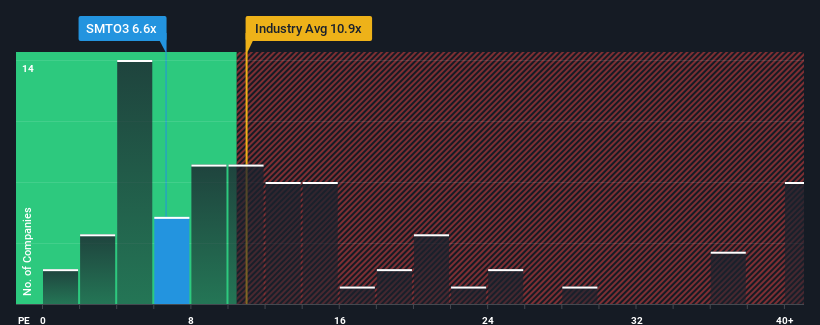Why Investors Shouldn't Be Surprised By São Martinho S.A.'s (BVMF:SMTO3) Low P/E

São Martinho S.A.'s (BVMF:SMTO3) price-to-earnings (or "P/E") ratio of 6.6x might make it look like a buy right now compared to the market in Brazil, where around half of the companies have P/E ratios above 11x and even P/E's above 17x are quite common. Although, it's not wise to just take the P/E at face value as there may be an explanation why it's limited.
Recent times have been advantageous for São Martinho as its earnings have been rising faster than most other companies. It might be that many expect the strong earnings performance to degrade substantially, which has repressed the P/E. If not, then existing shareholders have reason to be quite optimistic about the future direction of the share price.
See our latest analysis for São Martinho

Does Growth Match The Low P/E?
There's an inherent assumption that a company should underperform the market for P/E ratios like São Martinho's to be considered reasonable.
Retrospectively, the last year delivered an exceptional 35% gain to the company's bottom line. Pleasingly, EPS has also lifted 40% in aggregate from three years ago, thanks to the last 12 months of growth. Therefore, it's fair to say the earnings growth recently has been superb for the company.
Turning to the outlook, the next three years should bring diminished returns, with earnings decreasing 10% each year as estimated by the nine analysts watching the company. That's not great when the rest of the market is expected to grow by 17% each year.
In light of this, it's understandable that São Martinho's P/E would sit below the majority of other companies. Nonetheless, there's no guarantee the P/E has reached a floor yet with earnings going in reverse. Even just maintaining these prices could be difficult to achieve as the weak outlook is weighing down the shares.
The Final Word
Using the price-to-earnings ratio alone to determine if you should sell your stock isn't sensible, however it can be a practical guide to the company's future prospects.
As we suspected, our examination of São Martinho's analyst forecasts revealed that its outlook for shrinking earnings is contributing to its low P/E. Right now shareholders are accepting the low P/E as they concede future earnings probably won't provide any pleasant surprises. It's hard to see the share price rising strongly in the near future under these circumstances.
We don't want to rain on the parade too much, but we did also find 3 warning signs for São Martinho (1 is a bit unpleasant!) that you need to be mindful of.
You might be able to find a better investment than São Martinho. If you want a selection of possible candidates, check out this free list of interesting companies that trade on a low P/E (but have proven they can grow earnings).
New: Manage All Your Stock Portfolios in One Place
We've created the ultimate portfolio companion for stock investors, and it's free.
• Connect an unlimited number of Portfolios and see your total in one currency
• Be alerted to new Warning Signs or Risks via email or mobile
• Track the Fair Value of your stocks
Have feedback on this article? Concerned about the content? Get in touch with us directly. Alternatively, email editorial-team (at) simplywallst.com.
This article by Simply Wall St is general in nature. We provide commentary based on historical data and analyst forecasts only using an unbiased methodology and our articles are not intended to be financial advice. It does not constitute a recommendation to buy or sell any stock, and does not take account of your objectives, or your financial situation. We aim to bring you long-term focused analysis driven by fundamental data. Note that our analysis may not factor in the latest price-sensitive company announcements or qualitative material. Simply Wall St has no position in any stocks mentioned.
About BOVESPA:SMTO3
São Martinho
Engages in the production and sale of sugar, ethanol, and other sugarcane byproducts in Brazil.
Very undervalued average dividend payer.
Similar Companies
Market Insights
Community Narratives



